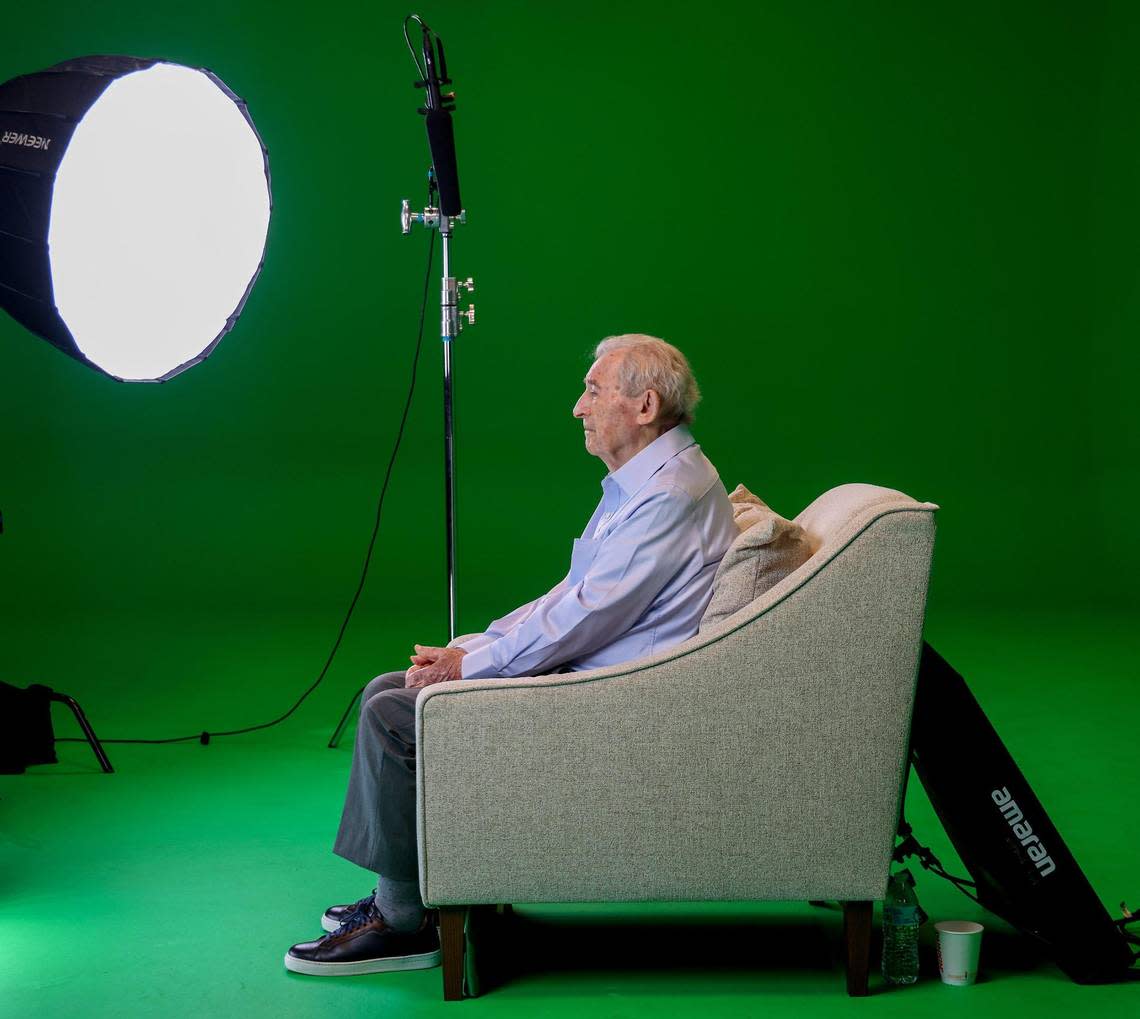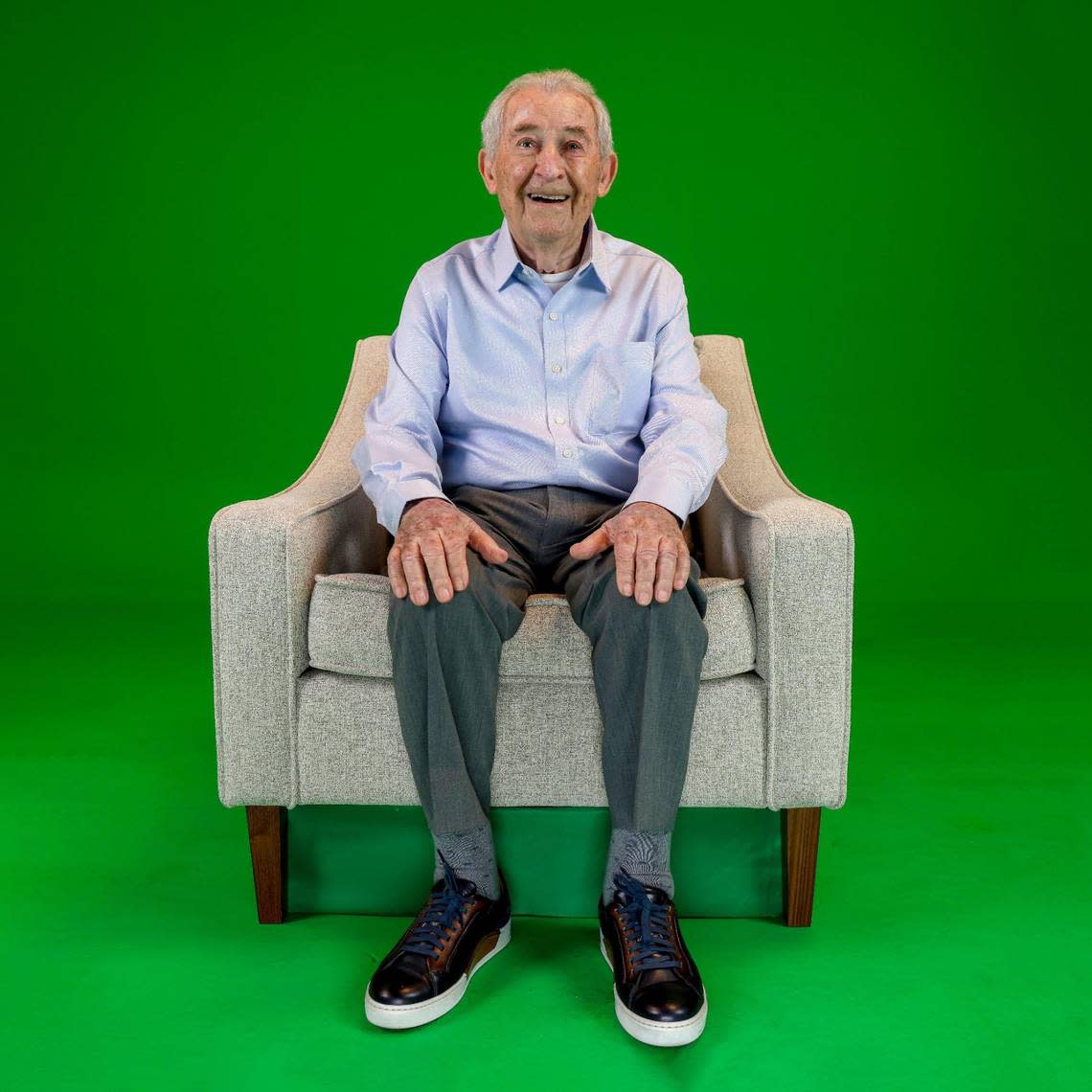A 93-year-old Miami Holocaust survivor will tell his story for decades to come. Here’s how
Even at 93, David Schaecter still thinks about the children around him at concentration camps during the Holocaust.
He mourns the entire generation that was systematically murdered, robbed of the opportunity to rebuild their lives. Their memory has pushed him to educate youth today about the horrors he witnessed.
“I want them to tell the story that they heard me telling them when I’m no longer,” he said. “That’s what gives me strength.”
Schaecter, a Holocaust survivor who has lived in Miami for almost seven decades, will be transformed into a hologram that will be displayed in museums through the University of Southern California Shoah Foundation’s Dimensions in Testimony project. Schaecter is answering more than 1,000 questions about his life journey and legacy during the week of International Holocaust Remembrance Day, which is Friday, Jan 27.
Holograms, three-dimensional projections of a person, have even been used in performances with famous artists like Michael Jackson. Schaecter’s interactive hologram will answer visitors‘ questions about his experiences, allowing future generations to hear accounts from Holocaust survivors when most will have passed on.
The exhibit will appear at the Boston Holocaust Museum when it opens in 2025 and may make its way to other museums, including the Holocaust Memorial in Miami Beach, which Schaecter helped establish.
Born in what was then-Czechoslovakia, Schaecter was 11 when World War II intensified. He survived four concentration camps during his teen years, including Auschwitz and Buchenwald. But Schaecter lost his parents, two sisters, a brother and about 100 other relatives in the genocide.
At 15, he was alone.
Bringing a story to life
For Holocaust educator Michael Berenbaum, Schaecter’s story is one that resonates with children and teens.
“What 15-year-old is not going to imagine: ‘What would I do if I were all alone and lost everyone and everything?’ ” Berenbaum said.
Dialogue with survivors has proven to be the most effective tool in Holocaust education, said Berenbaum, who has helped create many Holocaust museums around the world. Schaecter’s hologram will draw on the power of story, giving young people an opportunity to engage with a survivor beyond his lifetime.
Schaecter’s testimony also draws lessons about resilience through the toughest of times. He was able to rebuild his life after the Holocaust, moving to the U.S. in 1950, studying industrial engineering and later owning his own company.
“You also have the capacity to transform a memory of suffering into a beacon of hope,” Berenbaum said. “It is an urgent message for every generation, most especially this one.”

To help bring life stories to museums, the USC Shoah Foundation started developing the project since 2010, said Ryan Fenton-Strauss, the foundation’s director of media archives. The team has explored camera technology, display technology and natural language processing, which allows computers to understand spoken words.
They also developed a list of more than 1,000 questions to ask survivors, Fenton-Strauss said. The bulk focus on Schaecter’s accounts of the Holocaust. A few were minor details in which surveyed kids expressed interest, such as knowing what a survivor’s favorite color was.
“There’s an incredible intimacy to this,” Fenton-Strauss said. “This is not an easy task that we’re asking [Schaecter] to go through. He’s gonna relive his experiences.”
After the Miami interviews this week, the team will take the recordings back to Los Angeles, develop the hologram, test it by asking questions and troubleshoot it to prepare it for its 2025 unveiling.
A living legacy
In 2018, Jody Kipnis stood in front of Bunker 8 in Auschwitz with Schaecter when he said something that changed her life: Hear me, listen to me and tell my story.
Kipnis was a dental hygienist who avoided speaking about the Holocaust. But after the March of the Living trip that Schaecter led, she has dedicated herself to educating others about the tragedy. Kipnis became the CEO and president of the Holocaust Legacy Foundation and pushed to co-found the Boston Holocaust Museum.
When the museum opens in 2025, Schaecter’s hologram will appear after a short film about his life. Kipnis wants to create an intimate and immersive experience where visitors can ask questions from their seat in the theater. A visit to a museum near Chicago with a hologram of a survivor felt so real that she wanted to embrace the hologram.
“The stories will live on for many, many years ... after the survivors are gone,” Kipnis said. “It’s the closest we’ll get to having them feel like they’re talking to survivor.”
Kipnis, as she plans the museum, reflects on the time a crowd of students gathered around Schaecter in Poland. What he told her is ingrained in her mind: If they don’t hear my voice, whose voice will they hear?

Through the exhibit, people will hear Schaecter’s voice for generations to come.
“I made a commitment to myself that I wanted to tell young people,” he said. “Children need to know history. Children need to know that there’s so much ugliness that exists. Children need to know that they just mustn’t [be] standing by.”
